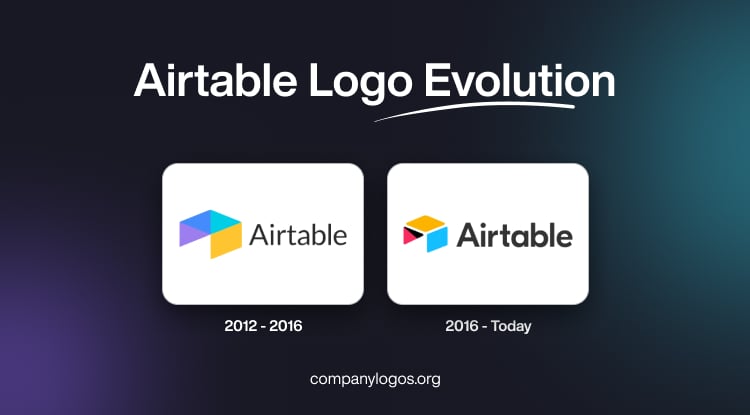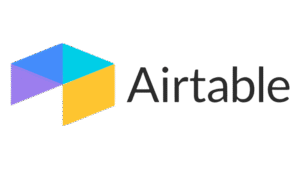
Airtable is an American cloud collaboration service company that builds and shares relational databases to simplify complex data organization. Founded in 2012, Airtable allows users to develop custom solutions to organise, manage, and share data, thanks to its powerful features and user-friendly interface.
The journey of the Airtable logo has been a remarkable one. Its 3D geometric shapes feature a modern and abstract design. From its inception to the present day, the Airtable logo has evolved and reflects the growth of the company and its ability to adapt to changing design trends. This article delves into the history and evolution of the Airtable’s iconic logo.
The Genesis of the Airtable Logo (2012 – 2016)
In 2012, when Airtable was still in its infancy, the logo of the company embraced a minimalistic approach. It featured a stylized 3D geometric figure that looked like a floating cube and was composed of distinct colours. These include teal, a shade of blue, flat purple, and yellow. These vibrant colours gave the logo an innovative and dynamic feel and symbolised wisdom, creativity, and energy. Alongside the graphical element was the wordmark “Airtable,” executed in bold black and in a sans-serif font.
The black wordmark stood in stark contrast to the multi-coloured geometric figure. Also, the letter “a” in the wordmark came with rounded contours to reflect the soft edges. In fact, the design of the letter “a” conveyed user-friendliness and approachability of the brand. The overall logo design embodied a combination of sophistication and simplicity. It showed the functionality of Airtable and its calculated approach to data management.

Embracing Modernity (2016 – Today)
As Airtable gained traction and expanded its user base, the company recognised the need to evolve its visual identity. As a result, in 2015, the logo underwent a significant transformation by embracing a more modern and geometric aesthetic. The new logo design has a graphical figure appearing like a stylized table and comprising three colours. And beside the vibrant and dynamic graphical figure lies a traditional wordmark rendered in title case and in a regular sans-serif font. The bold wordmark enhances readability compared to the earlier iteration.
The graphical figure comprises three geometric elements: a triangle and two parallelograms. And when it came to the colour scheme, the triangle sports a red colour with pink shades and a diagonal shadow cutting across the upper portion. The parallelogram placed on top appears in yellow, and the figure on the side looks radiant in a bright turquoise blue colour. Interestingly, the colour of the text “Airtable” stands in sharp contrast to the brightness of the graphical entity.
This updated logo aims to capture the essence of Airtable’s innovative approach to data management. It blends functionality with a visually appealing design. The geometric elements convey a sense of structure and organization. At the same time, the clean lines and bold colours display a fresh and dynamic brand personality.

The Elements of the Airtable Logo
Font
The Airtable wordmark bearing the name of the brand is executed in a traditional sans-serif typeface. Its clean lines and straightforward appearance are similar to fonts such as Reaktif Bold, Lto. Poligon Bold, and XXII Geom Bold.
Colour
The colour palette of Airtable infuses a burst of energy and delight into the otherwise conventional and staid typographic elements. The brand’s graphical element combines bright shades of yellow, turquoise, and red. These shades create a vivid contrast against the grey tones of the wordmark. This vibrant colour combination evokes a sense of progressiveness and creativity. Further, it effectively counterbalances any potential monotony associated with the typography.
The History of Airtable
In 2012, three visionaries, Howie Liu, Andrew Ofstad, and Emmett Nicholas, came together in San Francisco to create a revolutionary cloud-based platform. The platform was meant to enable users create custom solutions for data management. For two years, they toiled in secrecy and came out with a meticulously crafted digital platform called Airtable. Further, their dedication paid dividends in 2014 when a closed beta was unveiled to show the world their extraordinary creation.
In 2015, Airtable made its public debut with a significant investment of $3 million received from funds like CrunchFund and Freestyle Capital. This vote of confidence expressed by the two funds steered the growth trajectory of the company. Thereafter, in the following years, Airtable saw an influx of additional financial backing of approximately $60 million from investors such as CRV and a venture capital fund associated with celebrity Ashton Kutcher.
The year 2015 became a happening year for Airtable, as the platform went through a series of enhancements with the introduction of APIs, forms, and crucial integrations with tools like Slack. These enhancements helped strengthen the position of Airtable as a versatile solution that is capable of meeting the diverse needs of various industries. It allowed teams to build custom relational databases and streamline their operational processes.
By 2019, the user community of Airtable had expanded rapidly and increased the revenue of the company beyond the $100 million mark. The amount increased to a whopping $200 million by 2021. This remarkable growth trajectory culminated in Airtable attaining the coveted “unicorn” status in 2018. It did so after completing its Series C funding round, which valued the company at over a billion dollars.
While retaining its hallmark adaptability for spreadsheets, Airtable began offering out-of-the-box templates and features tailored for large enterprises. The year 2022 marked another significant milestone, with the company raising a staggering $735 million in funding. This elevated its valuation to an impressive $11 billion. This financial backing led to the expansion of the Airtable product suite and included the integration of artificial intelligence capabilities as well.
Since its launch in 2015, Airtable has carved a unique niche as a leading database collaboration platform. The continuous growth of the company in terms of revenue, an ever-expanding user base, and technological advancements amply prove its success and commitment to innovation.
Interesting Facts About Airtable
- Airtable combines the simplicity of spreadsheets with the power of databases. It allows users to manage and organize complex data in a familiar, user-friendly interface.
- Unlike traditional spreadsheets, Airtable supports a wide variety of field types, such as attachments, checkboxes, drop-down lists, barcodes, phone numbers, and linked records. These make it highly flexible for different use cases.
- Airtable empowers users, even those without coding skills, to build custom applications and workflows tailored to their needs. This helps democratize software creation for teams of all technical backgrounds.
- In 2024, Airtable launched AI-powered features like Cobuilder, which lets users build custom apps in seconds, and an AI assistant to streamline app management. These tools have quickly become some of the company’s most popular features.
- As of 2025, Airtable serves over 450,000 organizations worldwide. These range from small businesses to large enterprises, across industries like marketing, project management, content planning, and inventory tracking.
- Airtable achieved $204.7 million in revenue in 2024 and had an annual recurring revenue (ARR) of $375 million in 2023. It had high retention rates and significant enterprise adoption.
- The company was valued at $11.7 billion after its Series F funding in 2021. However, market corrections have since adjusted its estimated valuation to around $3.8 billion in 2024. Airtable has raised a total of $1.36 billion in funding.
- Airtable was founded in 2012 by Howie Liu, Andrew Ofstad, and Emmett Nicholas, with the mission to make software creation accessible to everyone.
- Airtable is used for CRM, project management, marketing campaigns, product launches, event planning, bug tracking, inventory management, and even personal projects like job hunting or content calendars.
- The platform offers real-time collaboration, customizable views (like Kanban, Calendar, Gallery), and integrates with hundreds of other tools and services. These make Airtable a central hub for team workflows.
- In 2024, Airtable acquired Dopt, an AI-powered onboarding platform, to further strengthen its AI capabilities.
- Airtable is a cloud-based service; while users can export individual tables as CSVs, full database downloads are not supported. This emphasises its collaborative and online-first approach.
Finally
Throughout its journey of evolution, the Airtable logo has undergone a single transformation. The redesigned logo iteration reflects the evolving design philosophy of the company and its ability to adapt to changing trends. Its current logo has remained a powerful visual representation of the core values of the company: functionality, simplicity, and innovation.